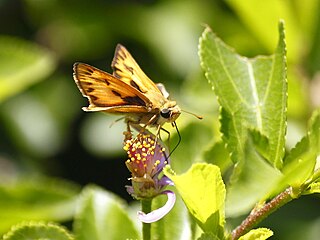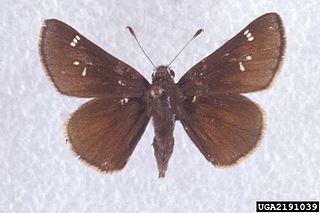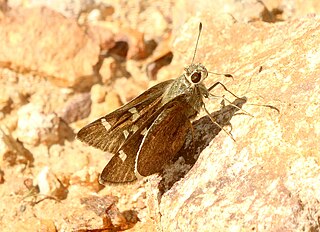
Skippers are a group of butterflies placed in the family Hesperiidae within the order Lepidoptera. They were previously placed in a separate superfamily, Hesperioidea; however, the most recent taxonomy places the family in the superfamily Papilionoidea, the butterflies. They are named for their quick, darting flight habits. Most have their antenna tips modified into narrow, hook-like projections. Moreover, skippers mostly have an absence of wing-coupling structure available in most moths. More than 3500 species of skippers are recognized, and they occur worldwide, but with the greatest diversity in the Neotropical regions of Central and South America.

Grass skippers or banded skippers are butterflies of the subfamily Hesperiinae, part of the skipper family, Hesperiidae. The subfamily was established by Pierre André Latreille in 1809.

The fiery skipper is a species of butterfly in the family Hesperiidae. Reaching approximately 1 inch (2.5 cm) in length, male fiery skippers are orange or yellow while the females are dark brown. Small brown spots may be observed on both the hindwing and forewing of both sexes although to a varying degree. Females may be darker brown overall with pale checkered markings on the hindwing. Fiery skipper larvae, or caterpillars, are greenish pink-grey with a black head and constricted neck. These larvae are often considered pests and can feed on Bermudagrass, creeping bentgrass, and St. Augustine grass.

Telegonus cellus, the golden banded-skipper, is a North and Central American species of butterfly in the family Hesperiidae. There are two populations, one in the eastern United States and the other in the southwestern United States and Mexico. The eastern population is rare and local and uses only one host plant, the thicket bean. The southwestern population is uncommon to common and uses more than one host plant. The golden banded-skipper is most active mid-morning and late afternoon. Their flight is sluggish and low to the ground, compared to closely related species.

Atrytonopsis is a genus of butterflies in the skipper family, Hesperiidae. They are native to Mexico and the southwestern United States.

Burnsius albezens, the white checkered-skipper, formerly known as Burnsius albescens and Pyrgus albescens, is a species of skipper. It is found at low altitudes in the southern United States and Mexico. It is a rare stray to southwest Utah and central Texas and is found in a variety of dry, open habitats.

The crystal skipper is a species of butterfly in the family Hesperiidae that is found only along a 30-mile (50 km) stretch of barrier islands in North Carolina. The skipper was first discovered in 1978 and the paper describing it as a full species was published in 2015.

Atrytone arogos, the arogos skipper or beard-grass skipper, is an endangered species of butterfly of the family Hesperiidae.

Atrytonopsis hianna, the dusted skipper, is a butterfly of the family Hesperiidae. It is found in the United States from eastern Wyoming, central Colorado, northern New Mexico and central Texas east to New Hampshire and Massachusetts, south to peninsular Florida and the Gulf Coast.

Phocides pigmalion, the mangrove skipper, is a butterfly of the family Hesperiidae. It is found in the United States from coast to coast in peninsular Florida and the Florida Keys, south through the West Indies and Mexico to Argentina. Strays may be found up to coastal South Carolina.

Euphyes dukesi, or Dukes' skipper, is a butterfly of the family Hesperiidae. It lives in the eastern United States and in a small portion of southern Ontario, Canada, in three distinct populations. Preferred habitats are shaded wetlands, with various species of sedge plants it uses as host plants for its larvae.

Problema bulenta, the rare skipper, is a butterfly of the family Hesperiidae. It is hard to find within the United States. The species was first described based on a drawing.
Euphyes berryi, known as Berry's skipper, is a rare species of butterfly of the family Hesperiidae, historically found in wet areas from North Carolina to Florida.
Atrytonopsis pittacus, the white-barred skipper, is a species of grass skipper in the family Hesperiidae. It was described by William Henry Edwards in 1882 and is found in Central and North America.
Atrytonopsis deva, the deva skipper, is a species of grass skipper in the butterfly family Hesperiidae. It is found in Central America and North America.

Atrytonopsis edwardsi, the sheep skipper, is a grass skipper butterfly in the family Hesperiidae. The species was first described by William Barnes and James Halliday McDunnough in 1916. It is found in Central and North America.
Atrytonopsis python, known generally as the python skipper or annual sea-blite, is a species of grass skipper in the butterfly family Hesperiidae. It is found in North America.
Atrytonopsis vierecki, or Viereck's Skipper, is a species of grass skipper in the butterfly family of Hesperiidae. It is found in North America.
Atrytonopsis cestus, the cestus skipper, is a species of grass skipper in the butterfly family Hesperiidae.

Atrytonopsis lunus, the moon-marked skipper, is a species of grass skipper in the butterfly family Hesperiidae. It is found in Central America and North America.
Burns, J. 2015. Speciation in an insular sand dune habitat: Atrytonopsis (Hesperiidae: Hesperiinae) - mainly from the southwestern United States and Mexico - off the Carolina coast. Journal of the Lepidopterists' Society 69(4):275-292.













